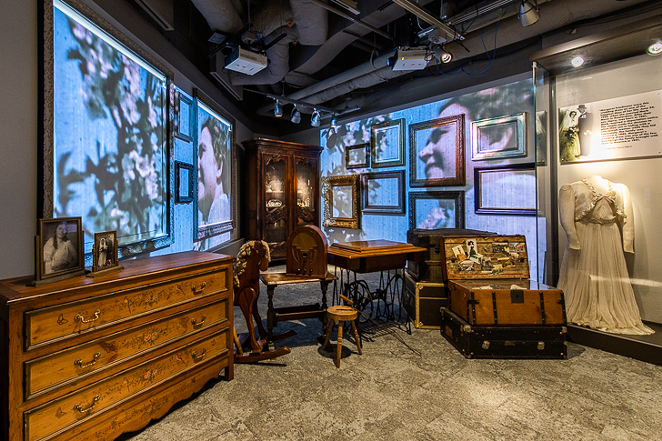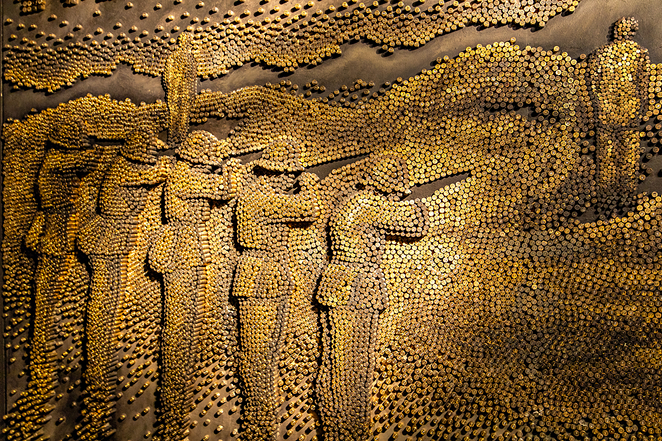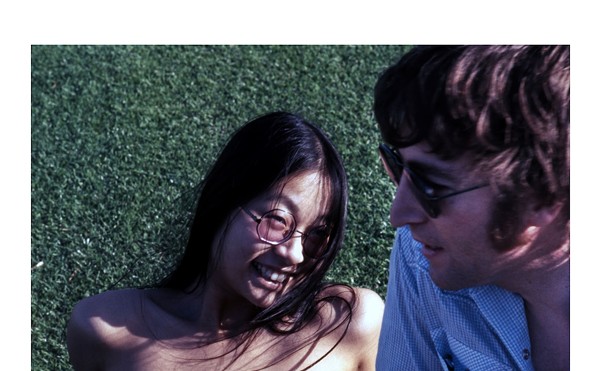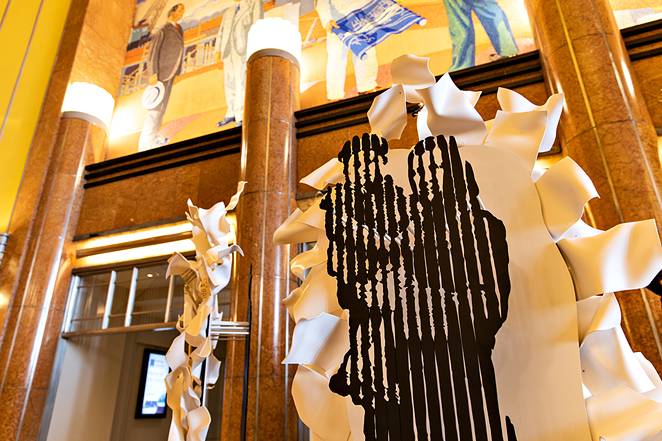
When Holocaust & Humanity Center Executive Director Sarah L. Weiss was still envisioning the museum’s move to prime space in the Cincinnati Museum Center at Union Terminal, she said she wanted her nonprofit institution to raise its visibility. Founded in 2000 by Holocaust survivors and their families, its small museum and educational programs had most recently been located inside Kenwood’s Rockwern Academy, a Jewish community day school.
“Over the years, people have said to us, ‘You’re a hidden gem,’ ” Weiss told CityBeat last year. “We don’t want to be a hidden gem.”
She doesn’t have to worry about that any longer. Recently opened in the concourse mezzanine level at the Cincinnati Museum Center, formerly home to the Cincinnati History Library and Archives, the Nancy & David Wolf Holocaust & Humanity Center now has approximately 7,500 square feet of exhibition space — three times more than when it was at the Kenwood school — with additional space for offices and programming.
Weiss expects the expanded museum to raise attendance tenfold or more, anticipating 75,000-100,000 visitors annually. As designed by the team of Michael Berenbaum and Edward Jacobs, with Jack Rouse Associates and USA Inc., it tells of the mass murder of 6 million Jews by Nazi Germany and its collaborators through exhibits, artifacts, photographs and audio and visual media.
There is ongoing relevance in learning from this past, Weiss says.
“Oftentimes history is a powerful tool to inform conversation,” she says. “So we definitely think this history, in particular, has relevance to some of the national debates going on today, as well as it brings awareness to all of us that unchecked hate is dangerous and a threat to all of us. On both of those levels, I think it has relevance to the civic conversation.”
While the museum shows how the Holocaust was a horrific event centered in Europe that spotlighted humanity at its worst, it also explains how it has had a long-lasting impact in Greater Cincinnati. It does so by including stories of those survivors who either escaped the Nazis or survived their death camps and came to Cincinnati to start new lives.
Weiss estimates some 2,000 Holocaust survivors made their way to the Cincinnati area and that 150-200 are still alive. These are people like Stephanie Marks, Zahava Rendler, Al Miller, Lou Weisser, Conrad Weiner and Henry Fenichel — survivors who appear in a short film that visitors see before touring the exhibits.
Onscreen, the local survivors urge viewers to learn from the past by always asking, “How can I be the best of humanity today?”
Weiss hopes this will differentiate Cincinnati’s Holocaust museum from others around the nation (like the United States Holocaust Memorial Museum in Washington, D.C.), thus answering those who question why such a high-profile community institution is needed here.
“I think one of our responsibilities in Cincinnati, far from where the Holocaust happened, is to tell the story in a way that connects to our community,” Weiss says. “And that connection is through the local individuals who built their lives here after the war. And we know we had World War II soldiers and liberators who were eyewitnesses to some of the atrocities of the Holocaust.”
“It’s easy for us to think that the Holocaust was more than 70 years ago in Europe, in such different times,” she continues. “It makes it closer and more tangible when we realize this happened to people in our own community who we may know or encounter, or their children or grandchildren.”
Most of the survivors arrived in Cincinnati via Union Terminal, then a bustling train station. One in five military service members also traveled through the station at some point during World War II, Weiss says. So there is a direct connection between the Holocaust & Humanity Center site and the story it tells.
That sense of place is very important, says exhibit designer Jacobs. He was in town last week from Israel to install a sculpture on the concourse’s main floor, above the museum, that will feature abstracted figures with facsimiles of the kind of documents needed by survivors to escape the Nazis and get into Cincinnati.
“We wanted to start with art. So young people — high-school students — learn how to look at something that’s not a screen that moves. This should have powerful significance,” Jacobs says. “In a world where place doesn’t matter anymore, this place matters. And when I look at something, I understand something of myself and it sets up what this is.”
Sharing the Pain
The museum consists of two separate galleries — the Holocaust Gallery and the Humanity Gallery — as well as two theaters that are named “Winds of Change” and “Point of Light.” There is also a 63-foot wall mural, created by local artist Keith Neltner and his Camp Springs, Kentucky-based design group, Neltner Small Batch. The mural uses a graphic-novel style to introduce visitors to the stories of 26 people, many with local connections, whose lives were touched by the Holocaust or World War II. Those stories are continued in the museum proper.
For all the attempts at localization, the Holocaust Gallery — which unflinchingly describes the details of how this genocide could happen — is the educational and emotional center of the museum. And with the newer, bigger museum expected to bring more annual visitors than the previous one, the Holocaust & Humanity Center will have a greater effect on the city’s cultural identity than ever before.
The museum sometimes uses eyewitness testimony from local survivors. That’s evident in a Holocaust Gallery installation called “Massacre,” which tells visitors of how 1.5 million Jews were murdered “bullet by bullet” in mass killings, often near their homes or villages. They never even made it to the camps.
The “Massacre” installation uses the audio testimony of a Cincinnati survivor, the late Sam Boymel, to give chilling detail to what happened. He was a boy when Nazis rounded up Jews in his town in Poland for summary execution. His detained mother told him to run, even giving him her sweater.
Another part of the installation is a film clip showing the execution of Jews in Latvia by German soldiers with assistance from Latvian collaborators. A victim is seen slain in a snowy trench.
For “Massacre,” the museum also commissioned a large wall piece that recreates a historic photograph of one such occurrence — it uses tens of thousands of bullet casings to depict its outrages.
Weiss says the installation has already had an unexpected impact on visiting students. “We had a kid (during a focus group) who said, ‘I’m from the massacre generation,’ ” she says. “What he was trying to say was (with) all of the school shootings and the mass killings, he feels like he sees this on the news. Even though it’s a different context, it started a whole dialogue about today.”
Another installation, called “Survival,” tells of the desperate existence in a death camp like Auschwitz. It contains a large reproduction of a painting by survivor David Olère, “The Food of the Dead for the Living,” which depicts him collecting food left behind in crematorium undressing rooms to throw over a fence to prisoners at the women's camp. The Auschwitz-Birkenau Memorial and Museum, located in Poland, gave the Cincinnati museum permission to show the reproduction. (An exhibit from the Auschwitz Museum is coming to New York’s Museum of Jewish Heritage this spring and will include at least one painting by Olère, who died in 1985.)
The role of trains in the museum’s narrative is more complex than just pointing out the role of Union Terminal. In the Holocaust Gallery, the museum decided to have windows overlooking the train yards behind the building. However, there is also a nearby installation called “Deportation” that reveals a more sinister use of trains. They were what the Nazis used to deport European Jews to the death camps. (There was actually a Cincinnati Holocaust-related exhibit at the Skirball Museum in 2012, brought here by survivor Sigmund A. Rolat, which also addressed the role of trains. At the time, Rolat told CityBeat that an innocuous-looking train schedule on display was “the most shocking document you will see here” because it recorded the time that a train packed with Jews left Czestochowa for the concentration camp Treblinka in Poland, as well as when the empty train returned to the city.)
“Typically, we think about the trains to death camps and destruction,” Weiss says. “But we’re also telling the story here about the trains to life, the trains that brought our survivors here to Cincinnati. Trains have always been this horrific symbol. Yet we’re in a train station; a train station that represents something totally different.”
Shining the Light
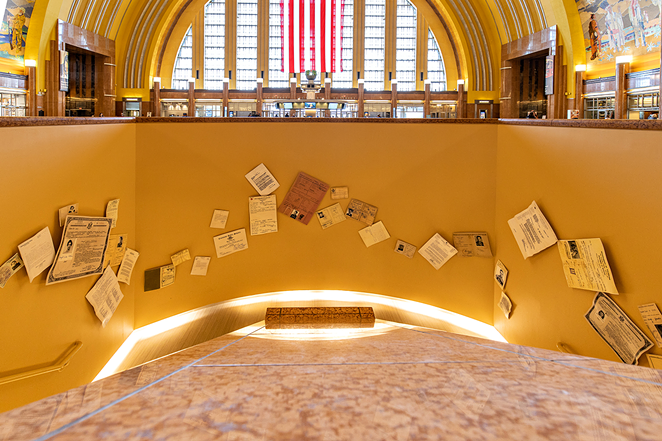
The Holocaust & Humanity Center also aims to offer visitors, in the museum’s words, a hopeful vision of future humanity through “stories of resistance and rescue, of messengers who warned the world while there was still time to act and of upstanders who risked their freedom and even their lives to assist the beleaguered.”
This is presented in the museum’s Humanity Gallery, which introduces — through interactive stations — profiles of many “upstanders” who have made a difference; not just Holocaust resisters and survivors but also those who have improved contemporary American life and Cincinnati life in particular.
One of those featured is the late Raphael Lemkin, a Polish Jew who escaped the Nazis in 1941 and spent much of his life arguing for international recognition of genocide as a crime. Another is Frank Gerson, a sanitation worker who started the Cincinnati Free Store to recycle still-useful tossed-out objects. Supreme Court Justice Ruth Bader Ginsburg is singled out for her work championing women’s equality as a young law professor and American Civil Liberties Union representative. Locally, Abdullah Powell is acknowledged for serving as creative director of Elementz, an urban arts center that teaches youth to express themselves through Hip Hop music, spoken word, dance and visual arts.
Weiss acknowledges that this approach is different from the message of earlier Holocaust awareness efforts that tried to impress the message “Never again” upon the visitors.
“It’s one thing to say never again be a victim or never again be a perpetrator or a bystander, but that’s harder to put into action,” she says. “It’s easier for us to explain the small moments where individuals have done good, or made a choice that helps another person or stood up to indifference. We know there’s still hate and discrimination in the world. Our hope is that our work can help to enhance people’s awareness that each of us has an ability to make a difference.”
There is, too, another aspect to this museum. It serves as a respectful tribute and memorial to survivors. When they have all passed, they won’t be forgotten by future generations. Instead, they will be honored at a museum in one of Cincinnati’s most cherished buildings.
Stephanie Marks, now 94, thinks such remembrance of survivors is important. After escaping with her parents from the Nazis in Belgium, they went to Portugal and then came to Cincinnati through the sponsorship of cousins who lived here. She had many Polish relatives murdered by the Nazis.
“Thousands of us survived,” Marks says. “It’s not just that we survived, we flourished. We married, we had children, our children were educated. We created two or three generations of wonderful people.
“We want people to know that despite what we went through, we progressed. We offered something to the world, in spite of it.”
Illustrating Heartbreak
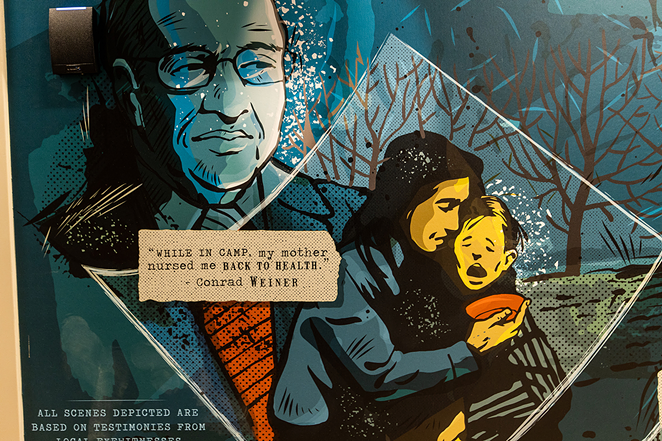
There is an important history in the use of the graphic-novel form to tell a Holocaust-related story.
The American artist Art Spiegelman won a Pulitzer Prize in 1992 for his book Maus, about his father’s experiences surviving the Holocaust as a Polish Jew.
Weiss of Cincinnati’s Holocaust & Humanity Center was certainly aware of that book, but it wasn’t a predominant reason for commissioning Kentucky’s Neltner Small Batch to create a 63-foot graphic-novel-style wall mural for the entrance to her museum’s new home at the Cincinnati Museum Center.
Rather, she thought the form might be a good way to introduce visitors to the stories ahead.
“Graphic novels are today very successfully being used in schools, so we thought this was a way to give some snapshots of the stories and the people they would meet in the museum in a kind of modern and fresh way,” she says.
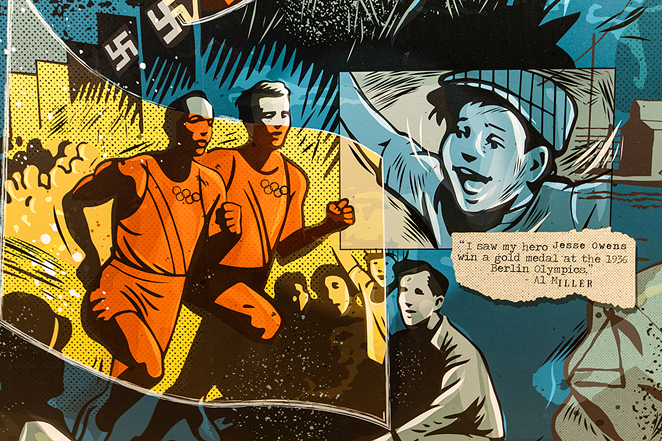
Neltner Small Batch’s Keith Neltner created the mural with Tom Post, Chris Dye, Andi Bussard and Andy Sohoza.
“The cool thing about the graphic-novel style is it’s really approachable,” says Neltner. “We can tell this really dramatic story that’s also relatable to all age ranges. And the subject matter is really intense.”
The mural was not painted directly onto the wall, but rather is a digital print on museum-quality linen.
“The final piece is a combination of digital illustration and hand-rendered layers of brush strokes, paint splatters and line work to create a dramatic finished piece,” Neltner explains in a Q&A done for the museum. “We wanted to create a sense of drama using color and not be too dark or intense with the tone.”
The mural — which also has a separate wraparound section on a nearby column — has fairly dark, blue-ish background alternating with white-bordered sections of flying “documents.” The importance of documents is a theme throughout the museum. Within the mural, stories of 26 individuals, most with local connections, come to vivid, colorful life via illustrations and captions.
For instance, local survivor Bella (Benozio) Ouziel remembers how, “At Auschwitz they took my sister from my arms,” while an illustration shows one Nazi restraining Ouziel while a second has grabbed the small child. Another illustration shows an African-American soldier arriving at Union Terminal — the caption quotes Herb Allen remembering that the first time he left home was to head to basic training in Georgia from the Cincinnati train station.
Chosen by the museum after a recommendation from ArtWorks, Neltner says he was selected because his company has done work with a lot of layering and depth — like a Brewery District mural and portrayals of heritage Country and Americana musicians, as well as graphic-oriented poster art.

Before landing a job, Neltner did a sample graphic-style portrait of Heinz (Henry) Blumenstein, who, as a 3-year-old Austrian child in 1939, traveled aboard the St. Louis, the famous ship with Jewish refugees from Nazism that had to return to Europe when Cuba wouldn’t let them disembark and the U.S. wouldn’t accept them. The family left the ship in the Netherlands, but once the Nazis invaded there in 1940 they were at risk. Henry survived the Holocaust in hiding; his mother and grandmother perished. He joined his father — who had escaped Austria earlier and was trying to have his family get to safety on the St. Louis — in the U.S. in 1946, after World War II’s end. Blumenstein lived for a time in Cincinnati before moving.
“The piece was pretty dramatic,” Neltner says of that first portrait. “It was using a lot of black tones in the background and taking the subject matter and striking that tone of seriousness and also vulnerability. If you see current portraits of survivors, they look like your grandparents. Then you learn their story and about their hardship.”
The finished mural incorporates a portrait of the elderly Blumenstein, which Neltner created from a provided photograph, and also one of him as a child with his mother, looking through a ship’s portal.
“Heartbreaking,” Neltner says succinctly.
To buy tickets to visit the Nancy & David Wolf Holocaust & Humanity Center at Cincinnati Museum Center, go to holocaustandhumanity.org/visit.

